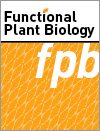Ver ítem
- xmlui.general.dspace_homeCentros Regionales y EEAsCentro Regional Mendoza - San JuanEEA MendozaArtículos científicosxmlui.ArtifactBrowser.ItemViewer.trail
- Inicio
- Centros Regionales y EEAs
- Centro Regional Mendoza - San Juan
- EEA Mendoza
- Artículos científicos
- Ver ítem
Mechanisms underlying photosynthetic acclimation to high temperature are different between Vitis vinifera cv. Syrah and Grenache
Resumen
Photosynthesis acclimation to high temperature differs among and within species. Grapevine intra-specific
variation in photosynthetic acclimation to elevated temperature has been scarcely assessed. Our objectives were to
(i) evaluate the mechanisms underlying long-term acclimation of photosynthesis to elevated temperature in grapevine,
and (ii) determine whether these responses are similar among two varieties. A warming experiment with well
[ver mas...]
Photosynthesis acclimation to high temperature differs among and within species. Grapevine intra-specific
variation in photosynthetic acclimation to elevated temperature has been scarcely assessed. Our objectives were to
(i) evaluate the mechanisms underlying long-term acclimation of photosynthesis to elevated temperature in grapevine,
and (ii) determine whether these responses are similar among two varieties. A warming experiment with well irrigated
Grenache and Syrah field-grown plants was performed during two growing seasons comparing plants exposed at
ambient temperature (control) with plants in open-top chambers (heating) that increased mean air temperature between
1.5 and 3.6 C. Photosynthetic acclimation was assessed through the response of net assimilation (An), Rubisco
carboxylation rate (Vcmax) and electron transport rate (Jmax), at leaf temperatures from 20 to 40 C. Our results
evidenced different mechanisms for photosynthetic acclimation to elevated temperature. Compared with control,
Grenache heated increased An, maintaining higher Vcmax and Jmax at temperatures above 35 C. By contrast, Syrah
heated and control presented similar values of An, Vcmax and Jmax, evidencing an adjustment of photosynthesis without
increasing C assimilation. Both varieties increased the optimum temperature for An, but to a lesser extent when growth
temperature was higher. Our study provides evidence that grapevine varieties present different acclimation mechanisms
to expected warming.
[Cerrar]

Fuente
Functional plant biology 48 (3) : 342-357. (2020)
Fecha
2020-12-07
Editorial
CSIRO Publishing
ISSN
1445-4408
1445-4416 (Online)
1445-4416 (Online)
Formato
pdf
Tipo de documento
artículo
Palabras Claves
Derechos de acceso
Restringido
 Excepto donde se diga explicitamente, este item se publica bajo la siguiente descripción: Creative Commons Attribution-NonCommercial-ShareAlike 2.5 Unported (CC BY-NC-SA 2.5)
Excepto donde se diga explicitamente, este item se publica bajo la siguiente descripción: Creative Commons Attribution-NonCommercial-ShareAlike 2.5 Unported (CC BY-NC-SA 2.5)

